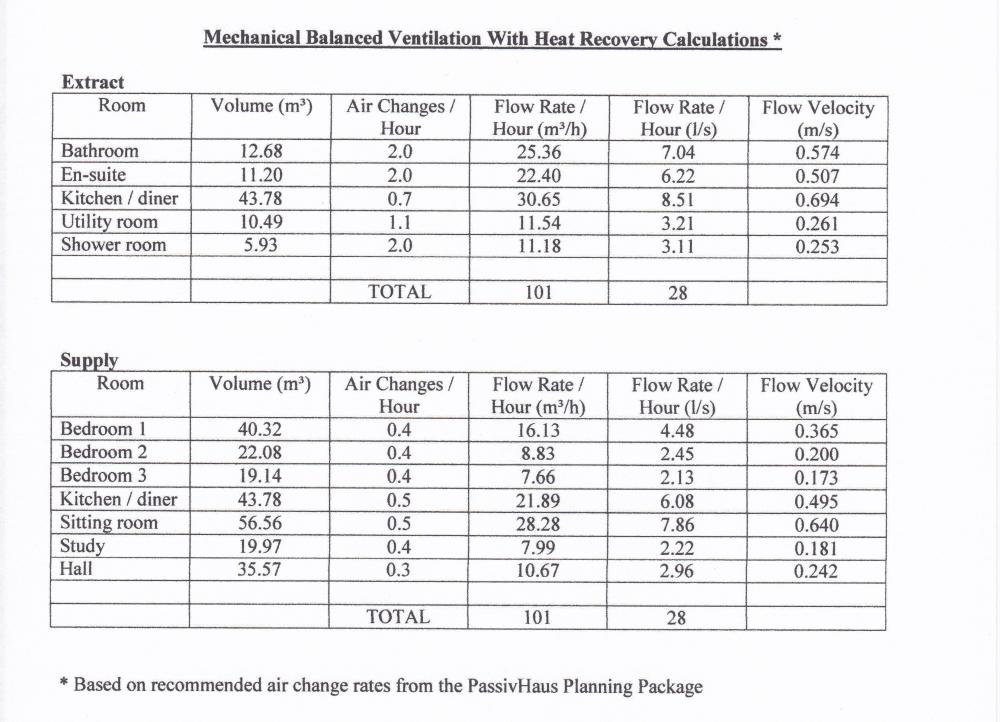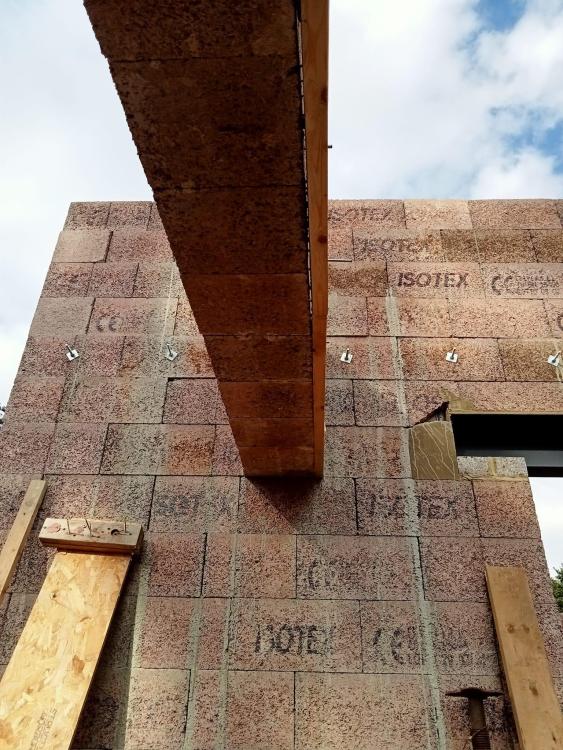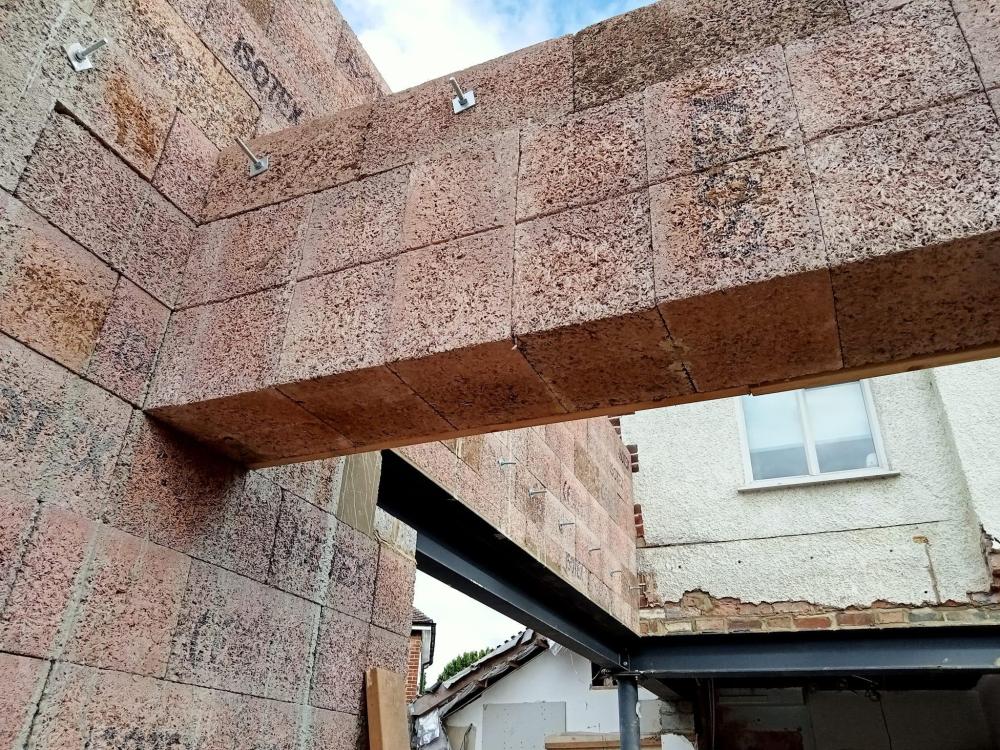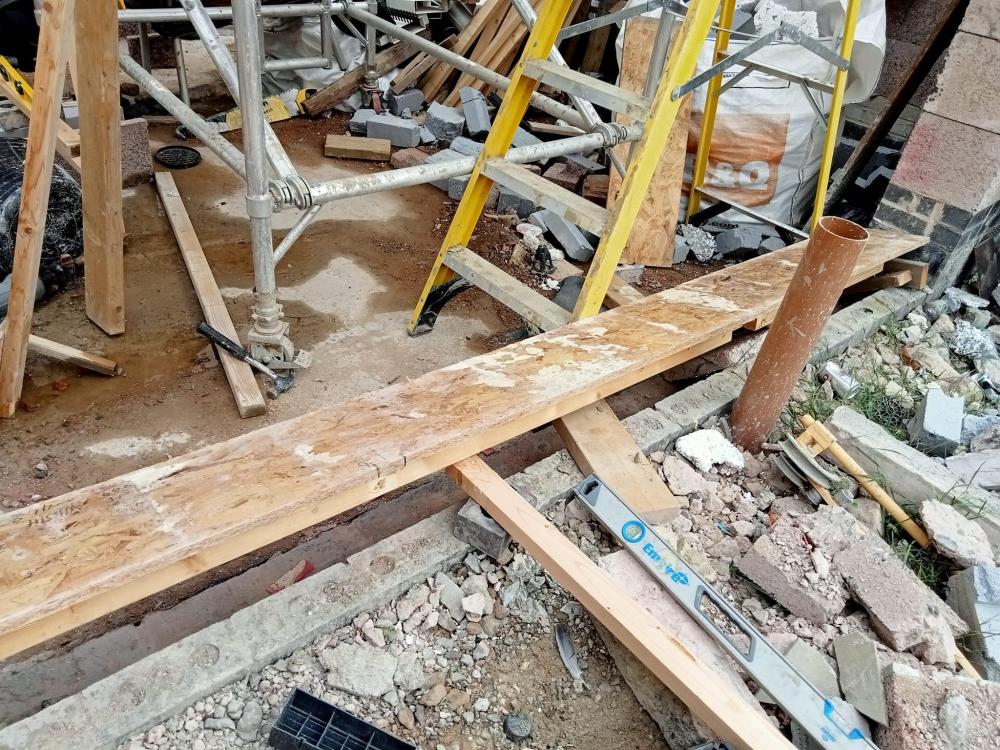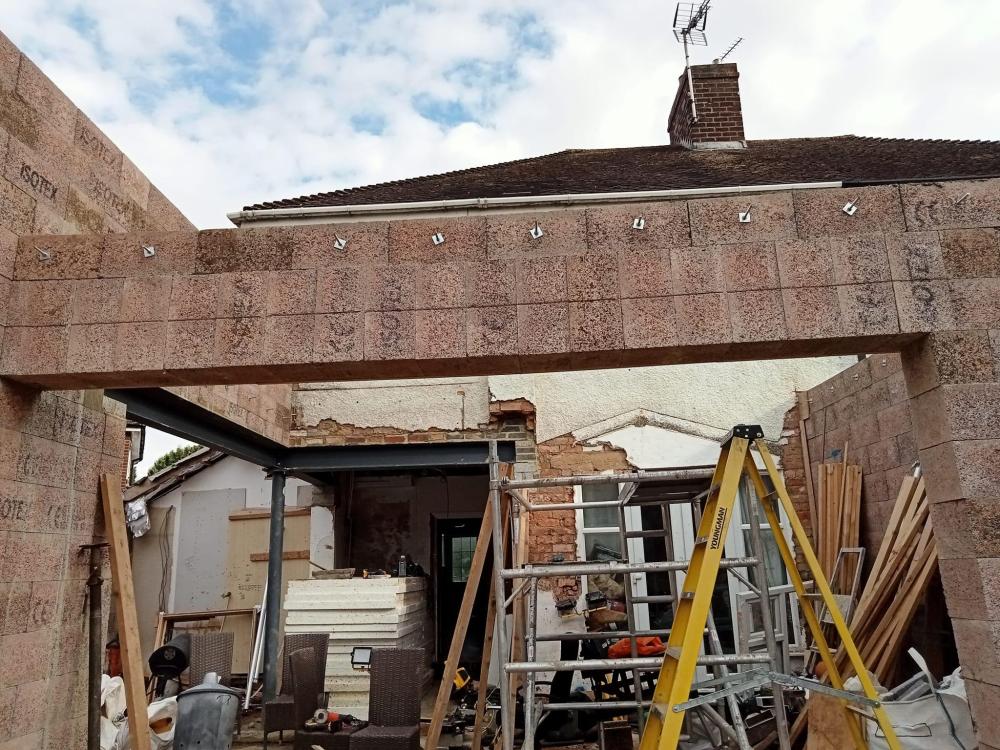Leaderboard
Popular Content
Showing content with the highest reputation on 08/01/22 in all areas
-
Just to be clear, if you are proposing to run a cable down the wall and out to the isolator, it is ONLY a safe zone if there is some electrical accessory on the inside of the wall to create the safe zone. e.g. if there was a socket on the wall directly below where the ASHP cable exits, then it would be a safe zone. If you really want to run the cable down then out, why not fit a 13A socket directly below the cable exit and you have created your safe zone, and an extra 13A socket is never going to be "too many" Far easier to fit an extra socket than a deep chase in the wall all the way down.2 points
-
That is down to how well you make the model. This was made with polystyrene and emulsion paint. Don't use PIR, not so easy to disolve. (I made it)1 point
-
Buy a cheap touring caravan. Work in comfort, kettle and toilet on hand.1 point
-
1 point
-
It's a brick house that will be full of books. Most likely no or nearly no carpets (because of allergies), except for a jute carpet for the cat to destroy. The main danger in case of fire coming from all of that is probably CO. More seriously - the issue is that we are talking about a large staircase that is the one escape route. We'd presumably be talking about the "well-ventilated" rather than the "smoldering" kind of scenario. The wall to be insulated is the one with the stained glass (which will be insulated by a glass pane on the outside). (Warning: bit of stair porn. It's probably the nicest part of the place as of now.) That may be a good idea. But wouldn't one need one in every room?1 point
-
We used a compact unit which was a Genvex Combi 185LS. It's a combined MVHR, hot water cylinder and EASHP. IIRC, we've since moved house, I set the fan levels at around 30% and we never changed that. We never used boost and we didn't have any condensation in the kitchen or bathrooms.1 point
-
Problem has been for the software developers getting their results to agree with all the BRE test cases. Elmhurst software just received approval at end of last week.1 point
-
Why don't "they" just say that until the new version actually works, just carry on using the old version? That's like Microsoft saying we have updated W11 and it does not work. Please be patient until we make it work, but in the mean time you can't go back to the old version.1 point
-
I'm running at half that, it only runs at 600 when on boost. I've more work to do getting everything fully working and properly setup.1 point
-
1 point
-
1 point
-
Except for it's insistence on charging the PW in the sublet during off-peak tariff time if PW is in need of charge and SE isn't. This is what annoys poor old Pocster so much becuase he doesn't want them exchanging their power reserves - ever!1 point
-
That's right. I suspect Pocster's install is wired in exactly the way RobLe shows it in (c) although which is batt is PW and which is SE is unclear. But it doesn't matter. It's the job of each battery to supply the power demand in preference to the grid except for when it is set to absorb power at off-peak times. Neither battery system can distinguish the house load from the other battery system if that battery system is being charged - therefore, if not actively charging itself, it will attempt to provide power for the other batteries charge. Again, it's a highly symmetrical problem so is unlikely to yield satisfactorily to an asymmetric solution.1 point
-
I could send you a good dose of rain from Scotland if you can tell me how to divert the clouds and send them down your way. On average, Glasgow was blessed with 885mm of precipitation last month but on the bright side our gardens look lovely! :]1 point
-
Everything helps bit by bit: - prevent roof from heating (reflective paint or coating) - remove hot air that collects in the attic (ventilation) - prevent top surface of insulation to capture radiant heat from underside of the roof (reflective film) - maximise insulation thickness (reduce speed of heat entering rooms) - increase decrement delay (so the heat flow created by day high temperatures is so slow that becomes cancelled out by nigh low temps) Superfoil is overpriced for what it does. Your 400mm of Rockwool does good job with stopping conduction, just lay something shiny on the top (emergency/space blankets). I'm not sure if a fan will improve flow a lot: temperature difference produces strong enough pressure to make a decent draught, it is the cross section of the roof vents that restricts the flow. Anectodal evidence is that when I open the loft hatch on the hot day the blow rips my head off (before roasting the rest)1 point
-
Legs on bed in master not level & 30mm air gap between headboard and external wall 😍1 point
-
You need to create a barrier to stop or rather delay the heat from passing from the outside into the inside. This is usually achieved by insulating with materials which have a high decrement delay. Do a search for decrement delay on this site, but effectively you want to utilise quite a lot of wood fibre products. From memory, you want to aim for a phase shift of about 11 or 12 hours.1 point
-
It's not normal to extracts in hallways, this would normally be a pass through area. So you supply a dry room the air flows through that room through corridor and across a wet room to the extract. Master bedroom flow looks low, I would bump up to 40-45m3h, also bump up the lounge. Wet room flows look a little low also. You need to get the flow and return rates the same, so the system is balanced. I set mine as follows Passivhaus house asks for 0.3ACH, Scottish building regs 0.5ACH. worked out the room flows at passivhaus flow rates, prorated the flows up to Scottish building regs flow rates, to give an overall 0.5ACH. After sign off, I can easily slow the fan speed down to get 0.3ACH. I would delete the extracts from the hallways, only extract from the workshop and plantroom. An airing cupboard if you do anything should be extract not supply, as its for drying damp things out. Once you have sign off, you will find that with a big house in cold weather your relative humidity may be low, unless you have a house full of people. As you are really over ventilating the house. Passivhaus say on a large low occupancy house 0.25 ACH may be the correct figure.1 point
-
There's a good amount of detail here, but you could add more. For example, you specify the thickness of PIR in the buildups, but I'm not sure all PIR is equal. Aren't there different types? Similarly, in one part you state "100mm of sound insulation", but that is area where there are all sorts of densities and materials available. You should choose something specific and specify it. Your skylights don't show any insulation detail. Velux for example supply insulation collars for their skylights separately. Similarly, flashing kits don't appear to have been specified. These are all things I assumed would be included as part of my tender and then discovered they weren't. Added cost and the surprise is never welcome. A couple of other amendments you should consider: If the loft is intended to be usable space, rather than just storage, I would seriously consider investing in: wood fibre insulation. You need quite a lot of thickness to make it worthwhile, at least 160mm but preferably more, and of course you'll need to run calcs to make sure your build up complies with regs, which bizarrely only care about insulation in winter, not summer. This will increase the decrement delay making it cooler by delaying the heat transfer time to a time when it is cooler outside so that you can open the windows and purge heat quickly; and external blinds for your two skylights. For sound proofing, where you've specified 15mm of soundbloc plasterboard. It's better to double up on this and stagger the joints. Have you specified the pipe thickness and type for the UFH? I couldn't see that.1 point
-
Fyi when picking a unit don't pick one that can barely meet the flow rates, you want a good bit of head room. We needed 600m3hr but the combined capacity of my two units is 800m3hr. For a 380m2 house you'll struggle with a single unit, that's why we went for two.1 point
-
You need to add boost also, if you haven't done so already. You need to look at min and max flow rates and size bigger than you think you need, so next size up ideally. Otherwise the system will have too much fan noise. You want the fan running as slow as possible while meeting your flow requirements. Flow is the same for supply and extract, the manufacturer figure is either the extract or supply rate, as they are both the same.1 point
-
When I had doubts, I placed my planks one at a time on the ground supported at each end on a 4" concrete block. Then i stood in the middle and jumped up and down on it. If it did not snap or bend excessively, I used it.1 point
-
So? £16k + £30k + £7.5k and then possibly + £5k = £58.5k total you’re paying for the entire plumbing install as described?1 point
-
1 point
-
Glue it and it should be fine, if you are worried about the joint put a couple of noggins in to support the joint1 point
-
I have never done that with short ends, with proper glue it becomes one piece, never had a problem and no squeaks!1 point
-
I need the same sort of thing so watching with interest.1 point
-
1 point
-
If you could cancel the load imposed by each battery system when charging from the other's CT (by routing their live wires in the opposite direction to the main incomer) then they will both only respond to the other house loads. But when current goes the other way, when generating, my head explodes. I mean, I haven't figured out what would happen yet!1 point
-
Tesla Q&A: Makes it sound very condescending! It might if there's a compelling reason to. Huff.1 point
-
Rob is on to something, here is a similar issue with competing surplus diversion boxes getting their knickers in a twist. https://community.openenergymonitor.org/t/arduino-based-mk2-pv-diverter-being-resurrected/11713/2 To quote from the thread The user whom I helped had just two systems - I think battery and water heating, and his problem was the two systems oscillated, stealing power from each other alternately. I suggested that he ran the wire feeding his immersion heater backwards through the grid c.t. of the other system, so its current in the main cable was cancelled out. So it knew nothing about the immersion heater, while the immersion PV system saw the battery charger as part of the normal house load, which automatically had priority. That solved the problem.1 point
-
Wow, I really hope your BCO ist that fussy. We have a quooker flex and it's wonderful(ly expensive).1 point
-
Leave it alone. Lapped the wrong way is not a problem. A bit of water pooling might be unsightly, but not a problem.1 point
-
Call me mental, but if the outlet is only a few mm higher could you try putting a piece of wicking material up and over the outlet? This would help to empty the pooled water quicker than evaporation alone. Probably.1 point
-
What you need to remember is that a standard scaffold board is designed to be supported every 1.2 m just because it’s longer does not mean it can be supported on just the ends.1 point
-
The boards are as close to perfect as I've seen. Twists can be levelled with a planer - need to take the metal end-cap off first, mind.1 point
-
My pet hate is when they are twisted so they don't lie flat.1 point
-
I’m pretty sure supply will outstrip demand very soon If it isn’t the case already We have had a sign up at the plots with my name and contact details on for the last six months and up and till three weeks ago no calls from the usual reps This past two weeks I’ve been contacted by 2 kitchen companies 1 window company 3 timber -builders merchants and a GSHP company our Joist suppliers have contacted me regarding ordering the roof Lead times down from 8 weeks to 2 weeks Pasquils have asked if they could re quote This is a massive contrast to six months ago when it was taking several weeks to get a response to an email enquiry1 point
-
I’d normally get someone semi retired and give the 150 per day It’s only going round filly cracks and patching after electricians and plumbers Most of the plasterers earn between 200 and 400 per day All price work So there not interested in patching1 point
-
Can you maybe find a union which will fit in the tank tapping (assuming there is one) and then find an in-line tap?1 point
-
Our gas pipe runs through insulated Posi rafters and is run in Copper (22mm). New gas boiler circa £500 to £1k, make the heating system low temperature, to future proof. You may need a buffer tank. Combi or system boiler up to you. If you do use a combi, get one that take preheated water such as an Atag, then you can have a cylinder upstream of the DHW that allows to use to solar preheated water later if required.1 point
-
@IanR I have to agree with you. Not sure how we are going to get the message across, hopefully the economic argument will do it, though this nation has a bit of history of making itself poorer.1 point
-
An excellent suggestion, unfortunately local plan dictates the roof style and mono pitch would not be allowed =(0 points
-
Spotted a YouTube .. “I made an oak door out of scaffold boards” … since when have scaff boards been oak.0 points








